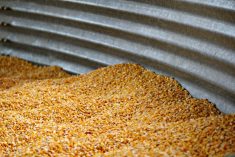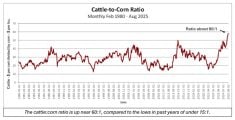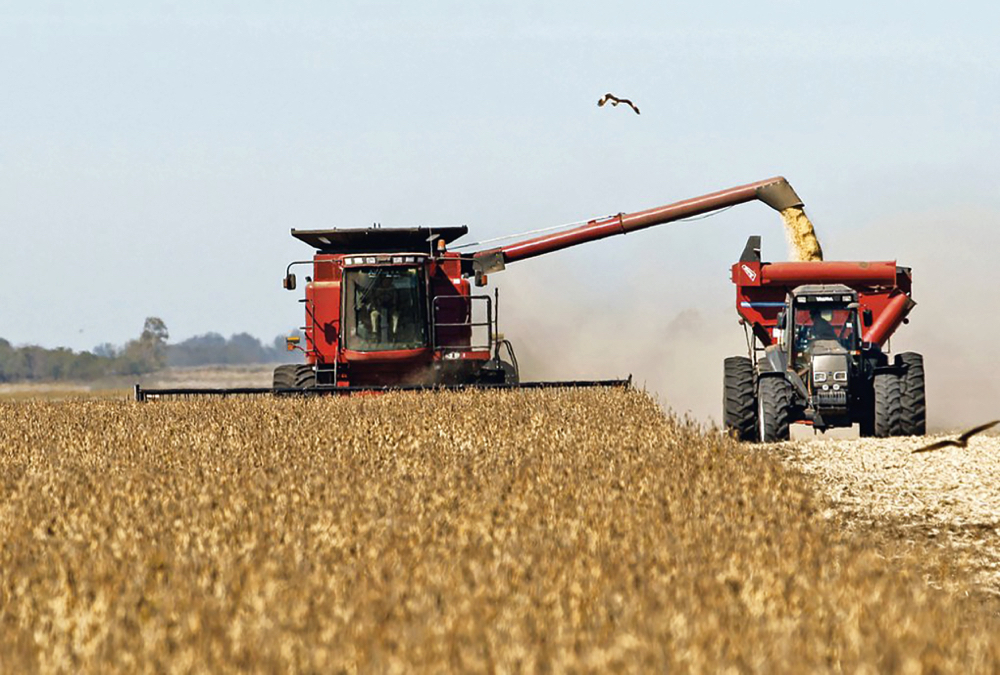Statistics Canada released its final crop production estimates on Dec. 4.
Corn production came in below expectations and below the September model-based survey. The adverse weather during harvest resulted in yield drag. Corn supplies will be tighter than expected in the latter half of the crop year.
Quick look
Soybeans: 2023 production was higher than the five-year average in Ontario.
Corn: There’s potential for a significant corn rally In spring 2024.
Wheat: There are rumours that Russia could implement export quotas on wheat.
Read Also

Scientists discover a gene that could triple wheat production
This discovery could give breeders a powerful new tool to boost yields without needing more land, water, or fertilizer.
Soybean production was down from our expectations but marginally higher than the September estimate. Soybean supplies will drop to bin-bottom levels at the end of the 2023-24 crop year. Wheat prices have rallied since U.S. Thanksgiving. This week, we’re advising producers to step up sales as export demand appears to be improving. Ontario farmers decreased winter wheat seeding in fall 2023 due to lower prices and the late soybean harvest.
As of Dec. 12, Argentinian farmers had seeded 42 per cent of the corn and 55 per cent of the soybeans. Conditions in Argentina are considerably better, resulting in a year-over-year increase in production forecasts.
Brazilian farmers have completed seeding of soybeans and the first corn crop. Soybean production is uncertain due to adverse weather. The trade is expecting a sharp year-over-year decrease in Brazil’s second corn crop.
The USDA increased the U.S. corn export projection in the December World Agriculture Supply and Demand Estimates (WASDE) as U.S. corn export sales are up 35 per cent from year-ago levels. There were no changes to the U.S. soybean fundamentals on the WASDE report.
There have been rumblings in the trade that Russia may impose export quotas on grains in the latter half of the crop year as the exportable surplus declines. China has been a large buyer of U.S. soft red winter wheat over the past month. The Chicago and Kansas wheat futures markets have experienced a counter seasonal rally post U.S. Thanksgiving.
We continue to have a neutral to negative outlook on the Canadian dollar. Canada’s economy contracted by 1.1 per cent in the third quarter of 2023 and recessionary pressures are expected to deepen in the first half of 2024.
U.S. economic growth is also expected to slow in 2024. It appears the U.S. Federal Reserve has achieved a soft landing. Higher U.S. interest rates have caused inflationary pressures to ease without causing a recession and massive layoffs.
However, it appears that Canada is in for a hard landing in 2024 as the economy contracts and the unemployment rate increases. This will cause Canadian dollar depreciation against the U.S. greenback.
Soybeans
Ontario farmers harvested four million tonnes of soybeans this fall, according to Statistics Canada. This was down from our estimate of 4.2 million tonnes but unchanged from last year. The five-year average production is 3.9 million tonnes. Farmers are expected to sell three million tonnes from Aug. 1 through Dec. 31, which will leave one million tonnes on farms as of Jan, 1, 2024. On-farm stocks are expected to drop to 500,000 tonnes on April 1, 2024.
The commercial pipeline will be rather low during the spring, causing basis levels to strengthen. Currently, the export market is reflecting stronger values than the domestic crusher. This will change from March through to the end of the crop year.
The Ontario domestic market will be premium to export values, resulting in imports from the U.S. Supplies in the U.S. will be extremely tight late in the crop year. U.S. soybean production came in at 112.4 million tonnes, down from the 2022 crop of 116.2 million tonnes. U.S. ending stocks for the 2023-24 crop year are expected to drop to 6.7 million tonnes, down from the 2022-23 carryout of 7.3 million tonnes.
This will be the second lowest carryout in eight years, to put the fundamentals into perspective. Export sales have improved over the past month due to problems in Brazil.
The southern states of Brazil experienced excessive precipitation and reseeding is underway. The USDA forecasted the Brazilian crop to finish near 161 million tonnes. This was down four million tonnes from the November estimate but up one million tonnes from last year.
We’re expecting further downward revisions in the Brazilian soybean crop. Argentina output will increase to 48 million tonnes, up nearly double last year’s output, which was only 25 million tonnes.
Currently, U.S. soybeans out of the Gulf and Ontario soybeans in the St. Lawrence are competitive with Brazilian origin. We’re expecting the main Brazilian harvest to occur 15 to 30 days later than normal due to adverse seeding conditions. There are still weather problems developing in Brazil and this situation is not over.
Argentinian soybeans are harvested in March and April but this is more important for the meal market. Argentina only exports about five million tonnes of soybeans and 24 million tonnes of meal.
Given the tight ending stocks in the U.S. and problems in Brazil, the U.S. soybean market needs to encourage acreage this spring through higher prices. Secondly, the market will be extremely sensitive to weather developments during the growing season. The soybean market needs to gain on corn as farmers make their seeding decisions.
What to do: We’ve advised Ontario farmers to be 50 per cent sold on their 2023 production. Be patient to make further sales. Ontario soybean stocks will decline and there will be strong domestic and export demand in the latter half of the crop year. We need to wait until Brazilian production is more certain and harvest pressure eases. We’re expecting a spring rally.
Corn
Earlier this fall, we were expecting the Ontario corn crop to finish near 10.1-10.4 million tonnes. According to Statistics Canada, Ontario farmers harvested 9.6 million tonnes, up from 9.4 million tonnes last year and up from the five-year average of 9.2 million tonnes. This is a major fundamental shift.
Farmers will sell 6.5 million tonnes from Sept. 1 through Dec. 31. On-farm stocks as of Jan. 1 are projected to be 3.6 million tonnes. In the latter half of the crop year, we’re anticipating a year-over-year increase in export and domestic demand. Ontario on-farm corn stocks at the end of the 2023-24 crop year expected to drop to 400,000 tonnes, down from the 2022-23 on-farm level of 496,000 tonnes and down from the seven-year average level of 900,000 tonnes.
Corn stocks will be snug in the summer of 2024. The domestic market will need to trade at a premium to world values to curb export movement.
At the time of writing this article, U.S. corn was offered at US$216/tonne f.o.b. the Gulf and Brazilian corn was quoted at US$231/tonne f.o.b. Paranagua. French corn was offered at US$232/tonne f.o.b. La Pallice. Ontario corn was quoted at US$205/tonne f.o.b. St. Lawrence port. Ontario corn is most competitive into northern European destinations. Export demand is the floor for the Ontario corn market.
The USDA had total Brazilian corn production at 129 million tonnes, down from 137 million tonnes last year. It’s important to realize that private trade estimates for Brazil are as low as 105 million tonnes. Usually, the smaller first corn crop, which is harvested in February, will be result in minimal exportable surplus.
The second crop will be seeded later than normal and will only be harvested in late June and early July. We’re expecting a sharp year-over-year decrease in Brazilian production and exports. Argentina production will likely finish near 55 million tonnes, up from 34 million tonnes. The year-over-year decline in Brazil will more than offset the increase in Argentina. The lower Brazilian output will be a major fundamental shift on the world stage.
U.S. corn production for 2023 came in at 387 million tonnes, up from the 2022 output of 349 million tonnes and up from the five-year average of 365 million tonnes. Given the larger production, the carryout is projected to finish at 54 million tonnes, up from the 2022-23 ending stocks of 35 million tonnes and up from the five-year average of 45 million tonnes.
The U.S. corn market is functioning to encourage demand through lower prices. Next year, lower prices will result in lower U.S. corn acreage. Analysts are expecting U.S. farmers to seed 90-91 million acres in 2024, down from the 2023 seeded area of 94.9 million acres.
What to do: We’ve advised farmers to be 40 per cent sold on their 2023 production. Be patient to make additional sales. We’re expecting a year-over-year decline in U.S. corn production. This will come on the heels of lower Brazilian output and exports.
Keep in mind that Ontario corn stocks are expected to drop to historical lows, which will drive up the Ontario basis. There is potential for a major rally in the corn market come the spring of 2024.
Wheat
Egypt held two large tenders during the first week of December. The second tender was filled with Russian origin at a price of $260/tonne f.o.b. Black Sea port. This is up from US$220-US$225/tonne on Nov. 28.
Strength in the Russian market has lifted the world wheat complex. The exportable surplus from Russia has decreased and there are rumours in the trade that the government will implement export quotas in the latter half of the crop year. Russia continues to target Ukraine infrastructure for grain exports. The conflict in the Middle East has spurred import demand from these countries. We’re starting to see more of a risk premium in the wheat market.
At the time of writing this article on Dec. 12, U.S. soft red winter wheat f.o.b. the Gulf was offered at US$276/tonne. This is up nearly $40/tonne from two weeks earlier. U.S. hard red winter was quoted at $300/tonne f.o.b. the Gulf, up $24/tonne from Nov. 28.
Australian milling wheat was valued at US$282/tonne f.o.b. Port Adelaide, South Australia. French soft wheat was offered at US$268/tonne f.o.b. Rouen, up only $21/tonne from 14 days earlier.
There has been strong demand from China for U.S. soft red winter wheat over the past couple of weeks. Ideas are that China will be looking for additional volume in January and February.
The Argentinean and Australian wheat harvests will be wrapped up by the end of December and harvest pressure will ease in January. There are no changes to production estimates. The Argentine crop will finish at 15 million tonnes, up 2.5 million tonnes from last year. Traders agree that Australia’s output will be 25.5 million tonnes, down from the previous harvest of 40 million tonnes. The lower production from Australia has caused China to step up imports from France and the U.S.
The Chinese wheat crop suffered severe quality downgrades due to rain during the harvest period. Keep in mind that it was only two years ago that China had a food security problem and it is not in the clear.
World wheat supplies among major exporters are historically tight and the market will be sensitive to crop development when the Northern Hemisphere wheat crop comes out of dormancy. The world cannot afford a problem in Europe or North America. Kansas remains on the dry side, as does Western Canada. France and Germany are in good shape so far. The strength in the corn market is more of a concern for Europe as nearly 50 per cent of the wheat moves into feed channels.
Ontario farmers harvested 2.7 million tonnes of wheat this past summer, up from 2.2 million tonnes last year. Export demand for Ontario wheat will increase later in February and March and we’re expecting stronger prices in spring.
Ontario farmers seeded 1.010 million acres of winter wheat this fall, down 100,000 acres from last year. Production will likely drop back to 2.2 million tonnes in 2024.
What to do: In this issue, we’re advising farmers to sell an additional 10 per cent of their 2023 wheat production, bringing total sales to 60 per cent. We’re planning on making our next sale in late February or early March.















